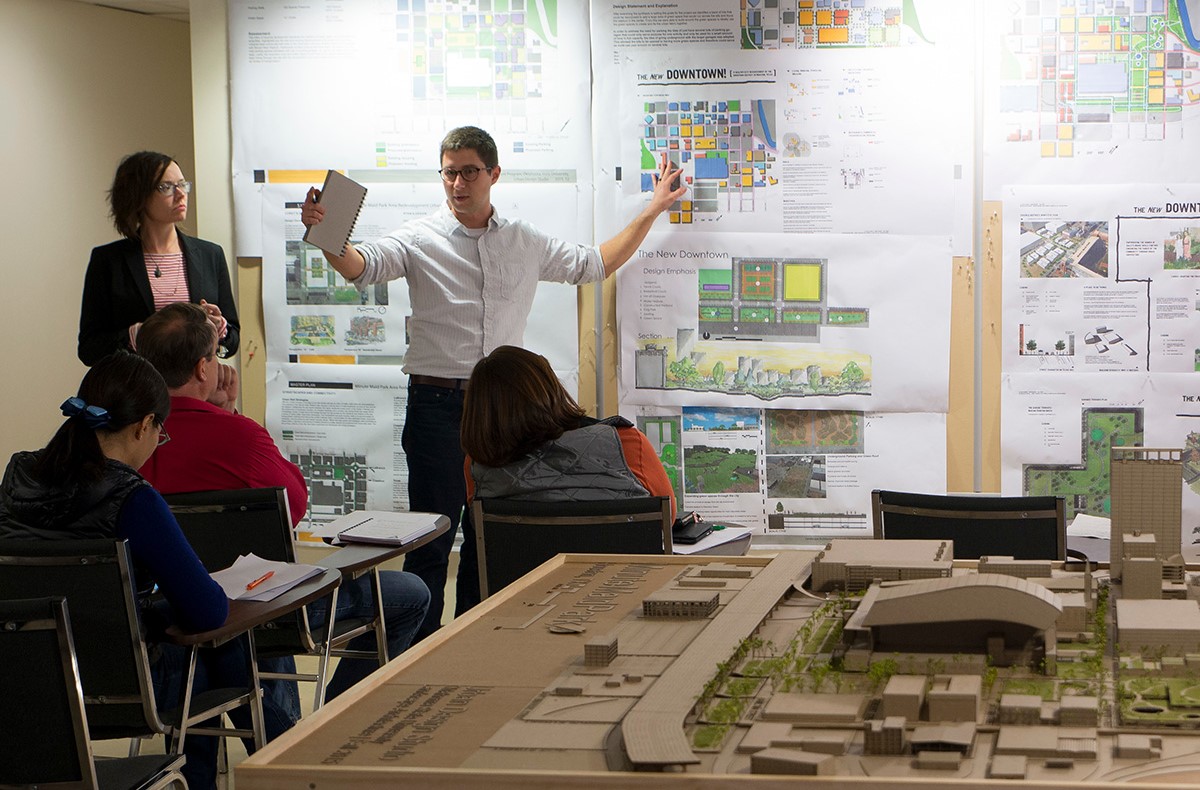Home>diy>Planning & Engineering>How Much Does A Landscape Architect Make Per Hour?


Planning & Engineering
How Much Does A Landscape Architect Make Per Hour?
Modified: January 9, 2024
Discover the average hourly rate for landscape architects in the planning and engineering field. Find out how much professionals in this industry make per hour.
(Many of the links in this article redirect to a specific reviewed product. Your purchase of these products through affiliate links helps to generate commission for Storables.com, at no extra cost. Learn more)
Introduction
Landscaping architecture is a profession that combines creativity and technical skills to design and create beautiful and functional outdoor spaces. It involves the planning, design, and management of both natural and built environments. Landscape architects play a crucial role in shaping the aesthetics and functionality of parks, gardens, urban spaces, and residential and commercial landscapes.
One common question that arises when considering a career in landscape architecture is how much does a landscape architect make per hour? The hourly wage of a landscape architect can vary depending on various factors, including experience, location, employer type, project type, and additional certifications.
In this article, we will delve into the factors influencing landscape architect hourly rates and provide insights into the average hourly wage for landscape architects. We will also discuss the variations in hourly wages based on experience, location, employer type, project type, and additional certifications. Lastly, we will explore the factors affecting wage growth for landscape architects.
Key Takeaways:
- Landscape architect hourly rates vary based on experience, location, employer type, project complexity, and certifications. Factors like urban demand and specialized skills can lead to higher earnings, making it a dynamic and rewarding profession.
- Wage growth for landscape architects is influenced by experience, education, networking, market conditions, specialization, and geographic location. By actively investing in professional development and staying informed, landscape architects can maximize their earning potential and build successful careers.
Factors Influencing Landscape Architect Hourly Rates
When determining the hourly rates of landscape architects, there are several factors to consider. These factors can greatly influence the amount a landscape architect can earn per hour. Some of the key factors include:
- Experience: Experience plays a significant role in determining hourly rates. Landscape architects with more years of experience and a proven track record of successful projects can command higher rates due to their expertise and level of skill.
- Location: Hourly rates can vary depending on the geographic location. Cities with a higher cost of living or a high demand for landscape architectural services tend to have higher hourly rates compared to rural areas.
- Employer Type: The type of employer can also influence hourly rates. Landscape architects working for large and prestigious firms or government agencies may earn higher hourly wages compared to those working for small firms or as freelancers.
- Project Type: The complexity and scale of the project can impact hourly rates. Projects that require more intricate designs, extensive research, and close collaboration with various stakeholders may command higher hourly rates.
- Additional Certifications: Landscape architects with additional certifications, such as LEED accreditation (Leadership in Energy and Environmental Design) or specialized training in certain areas like urban planning or sustainable design, might be able to charge higher hourly rates.
It’s important for landscape architects to carefully consider these factors when determining their hourly rates. Taking into account their level of experience, the local market conditions, the type of employer, the project requirements, and any additional certifications they possess will help them set reasonable and competitive hourly rates.
Now that we have explored the factors influencing landscape architect hourly rates, let’s move on to looking at the average hourly wage for landscape architects.
Average Hourly Wage for Landscape Architects
The average hourly wage for landscape architects can vary depending on several factors such as experience, location, and employer type. According to the U.S. Bureau of Labor Statistics (BLS), the median hourly wage for landscape architects was $33.54 as of May 2020.
However, it’s important to note that this is just an average figure and individual hourly rates can fluctuate based on the aforementioned factors. Landscape architect hourly rates can range from around $20 per hour for entry-level positions to over $60 per hour for highly experienced and specialized professionals.
In addition to the key factors mentioned earlier, other factors that can influence the average hourly wage for landscape architects include the demand for landscape architectural services in a particular area, the economic conditions of that area, and the level of competition within the industry.
It is worth mentioning that landscape architects often work on a project basis rather than solely relying on hourly rates. They may negotiate fixed fees or charge a percentage of the project’s total cost, especially for larger and more complex projects. The hourly rates mentioned here serve as a general guideline and can vary depending on the specific circumstances of each project and the agreements made between the landscape architect and the client.
Now that we have established the average hourly wage for landscape architects, let’s continue exploring the variations in hourly wages based on experience, location, employer type, project type, and additional certifications.
Hourly Wage Variations based on Experience
Experience is a significant factor that influences the hourly wage of landscape architects. As professionals gain more experience in the field, they often acquire additional skills, knowledge, and a track record of successful projects, which can translate to higher hourly rates.
Entry-level landscape architects with minimal experience typically earn lower hourly wages, ranging from around $20 to $30 per hour. As they gain more experience and develop a portfolio of successful projects, their hourly rates can increase. Mid-level landscape architects with 5-10 years of experience may earn hourly rates between $30 and $50.
Highly experienced and senior landscape architects, with over ten years of experience or a specialization in a particular area, can command higher hourly rates. These rates can range from $50 to over $60 per hour or even more, depending on the level of expertise and reputation. It’s important to note that these figures may vary depending on factors such as location, the demand for services, and the importance of the projects handled by the landscape architect.
Experience not only impacts the hourly wage but also plays a role in securing high-profile projects and clientele. Clients often seek experienced landscape architects who have a proven track record of delivering exceptional work. Therefore, as landscape architects gain more experience and develop a strong professional network, they often have the opportunity to work on higher-value projects, which can lead to an increase in hourly rates.
While experience is an important factor in determining hourly wages, it is not the sole criterion. Other factors such as location, project type, and additional certifications can also influence the hourly rate for landscape architects. Now, let’s delve into the variations in hourly wages based on location.
Hourly Wage Variations based on Location
The geographic location of a landscape architect can significantly impact their hourly wage. Hourly rates can vary based on the cost of living, the demand for landscape architectural services, and the level of competition within a particular area.
In general, urban areas and cities with a higher cost of living tend to offer higher hourly rates for landscape architects. For example, metropolitan areas like New York City, Los Angeles, and San Francisco typically have higher average hourly rates compared to rural or less densely populated areas. This is primarily due to the higher cost of living and the increased demand for landscape architectural services in urban settings.
Hourly rates for landscape architects can also vary from state to state. For instance, the BLS reports that as of May 2020, landscape architects in California had a median hourly wage of $39.49, while those in Texas had a median hourly wage of $30.71. Factors such as the local economy, market demand, and the presence of high-profile projects or clients in a state can all contribute to variations in hourly rates.
Location can also impact the range of projects and clients available to landscape architects. Urban areas often have a wider range of projects, including large-scale commercial developments, public parks, and high-end residential projects. These projects often have larger budgets, allowing landscape architects to command higher hourly rates. In contrast, rural areas may have fewer opportunities and lower budgets for landscaping projects.
However, it’s important to consider the cost of living when evaluating hourly rates. Higher hourly rates in urban areas may be necessary to offset the higher expenses associated with living and working in those locations.
In summary, location plays a significant role in determining the hourly wage for landscape architects. Urban areas and regions with a higher cost of living typically offer higher rates due to increased demand and competition. On the other hand, rural areas may have lower rates due to limited opportunities and smaller budgets for landscaping projects. Now, let’s explore the variations in hourly rates based on employer type.
Landscape architects in the United States typically make an average of $30 to $50 per hour, but this can vary based on experience, location, and employer.
Read more: How Much Is Landscaping Per Hour
Hourly Wage Variations based on Employer Type
The employer type can have a significant impact on the hourly wage of landscape architects. Different types of employers, such as large firms, small firms, government agencies, or self-employment/freelancing, can offer varying compensation structures and hourly rates.
Landscape architects working for large and prestigious firms or government agencies often have access to higher hourly rates. These organizations typically have larger budgets and can afford to pay more competitive wages. Additionally, they may offer additional perks and benefits, such as health insurance, retirement plans, and professional development opportunities, which can enhance the overall compensation package for landscape architects.
On the other hand, landscape architects working for small firms or as self-employed individuals/freelancers may have more flexibility but often face more variability in terms of hourly rates. Small firms may have limited budgets and might not be able to offer the same high hourly rates as larger firms. However, working for a small firm can provide opportunities for a diverse range of projects and potentially more creative freedom.
Freelance landscape architects can set their own hourly rates based on their experience, expertise, and market demand. However, they may also face challenges in terms of securing a consistent stream of projects and clients. Freelancers often need to market themselves, build a strong professional network, and continuously showcase their skills and portfolio to attract clients and secure higher-paying projects.
Ultimately, the hourly rates for landscape architects can vary based on the employer type. Larger and more established firms and government agencies may offer higher hourly rates and better benefits, while small firms and freelance landscape architects may need to carefully consider their overhead costs, market demand, and competition when setting their hourly rates.
In the next section, we will explore how the type of project can influence hourly wage variations for landscape architects.
Hourly Wage Variations based on Project Type
The type of project that a landscape architect works on can also have an impact on their hourly wage. Different project types require varying levels of complexity, research, and expertise, which can influence the hourly rates charged by landscape architects.
Large-scale commercial projects, such as shopping malls, office complexes, or urban redevelopment projects, often demand extensive planning, coordination, and design expertise. These types of projects may involve collaborating with architects, engineers, and other professionals, as well as working within strict timelines and budgets. Landscape architects involved in such projects may be able to command higher hourly rates due to the level of skills and expertise required.
Residential projects, including high-end residential estates or private gardens, can also vary in terms of hourly rates. Higher-end residential projects with significant budgets and intricate designs may offer higher hourly rates compared to smaller, more basic residential projects. The complexity and scale of the project, as well as the client’s budget and expectations, can impact the rates landscape architects can charge.
Public projects, such as parks, recreational spaces, or community developments, often have their own set of budget constraints and public funding considerations. Landscape architects working on public projects may need to account for these factors when determining their hourly rates. Hourly rates for public projects can vary depending on the level of government involvement, grant funding, and the size and scope of the project.
Specialized projects, such as rooftop gardens, sustainable designs, or rehabilitation projects, often require additional skills and knowledge. Landscape architects with expertise in these areas may be able to charge higher hourly rates due to the demand for their specialized services.
Ultimately, the hourly rate for landscape architects can vary based on the type of project they are working on. Larger and more complex projects may offer higher hourly rates, while smaller or less intricate projects may have lower hourly rates. The scope, scale, and requirements of the project, as well as the client’s budget and expectations, are all factors that influence the hourly rate for landscape architects.
In the next section, we will discuss how additional certifications can impact hourly wage variations for landscape architects.
Hourly Wage Variations based on Additional Certifications
In the field of landscape architecture, additional certifications and specialized training can have a significant impact on the hourly wage that landscape architects can command. These certifications demonstrate a higher level of expertise and knowledge in specific areas, which can make landscape architects more desirable to clients and employers.
One example of a certification that can positively influence hourly rates is the LEED accreditation (Leadership in Energy and Environmental Design). LEED-certified landscape architects have undergone training and demonstrated a deep understanding of sustainable design principles and practices. As sustainable design becomes increasingly important, clients are willing to pay a premium for landscape architects with this expertise. Therefore, landscape architects with a LEED certification may be able to charge higher hourly rates.
Furthermore, additional certifications or specialized training in areas such as urban planning, historic preservation, or ecological restoration can also impact hourly rates. These certifications demonstrate a commitment to continuous learning and a broader skill set, making landscape architects more versatile and valuable to clients. Consequently, landscape architects with additional certifications or specialized training may be able to command higher hourly rates compared to their peers without these qualifications.
However, it’s important to note that the impact of additional certifications on hourly rates can vary depending on the specific market and client base. The demand for particular certifications may be higher in certain geographic areas or for specific types of projects. Researching local market trends and understanding the needs and priorities of potential clients can help landscape architects gauge the value of specific certifications in their specific region.
When setting hourly rates, landscape architects with additional certifications should consider the tangible benefits that these certifications bring to their clients. For example, a LEED-certified landscape architect can emphasize the long-term environmental and cost-saving benefits that their sustainable design expertise can provide. By highlighting these benefits, landscape architects can justify higher hourly rates based on the value they bring to the project.
In summary, additional certifications and specialized training can positively impact the hourly wage of landscape architects. Certifications such as LEED accreditation and expertise in other specialized areas can make landscape architects more desirable to clients, allowing them to command higher hourly rates. It’s important for landscape architects to consider the market demand and specific client needs when determining the value and impact of additional certifications on their hourly rates.
Now that we have discussed the variations in hourly rates based on additional certifications, let’s move on to explore the factors affecting wage growth for landscape architects.
Factors Affecting Wage Growth for Landscape Architects
Wage growth for landscape architects can be influenced by several factors. Understanding these factors is crucial for landscape architects to plan their career paths and make informed decisions about their professional development. Some key factors that can affect wage growth for landscape architects include:
- Experience and Expertise: As landscape architects gain more experience and expertise in the field, their value to clients and employers increases. With each successful project and demonstrated skillset, landscape architects can negotiate higher hourly rates and pursue more lucrative opportunities.
- Continuing Education and Professional Development: Staying updated with the latest industry trends, technologies, and design approaches is essential for landscape architects to remain competitive. Engaging in continuing education programs, attending workshops, and obtaining additional certifications can enhance their expertise and increase their earning potential.
- Networking and Building Professional Relationships: Building a strong professional network can lead to new project opportunities and collaborations. Maintaining relationships with clients, contractors, and other professionals in related fields can open doors to higher-paying projects and referrals.
- Industry Demand and Market Conditions: The demand for landscape architectural services can fluctuate based on economic conditions, regional development trends, and environmental concerns. Staying informed about market demand and adapting to changing industry needs can help landscape architects position themselves for wage growth.
- Specializations and Niche Markets: Developing expertise in specific areas or targeting niche markets can differentiate landscape architects from their peers. Specializations such as sustainable design, urban planning, or historic restoration can command higher hourly rates due to the specialized knowledge and skills required.
- Geographic Location: The location in which a landscape architect practices can greatly impact wage growth. Cities with high demand for landscape architectural services and a higher cost of living may offer more opportunities for growth and higher hourly rates compared to rural or less densely populated areas.
It’s important to note that these factors are interconnected and influence each other. For example, a landscape architect who invests in continuing education and obtains additional certifications will likely enhance their expertise and marketability, leading to increased career opportunities and higher hourly rates.
Additionally, wage growth does not happen overnight. It is a gradual process that requires dedication, perseverance, and a commitment to personal and professional growth. By actively working on improving their skills, expanding their network, and staying informed about industry trends, landscape architects can position themselves for long-term wage growth.
In summary, wage growth for landscape architects is influenced by factors such as experience, education, networking, market conditions, specialization, and geographic location. By understanding and actively working on these factors, landscape architects can maximize their earning potential and build a successful career in the field.
Now, let’s conclude our discussion on the factors affecting wage growth for landscape architects.
Conclusion
In conclusion, the hourly wage for landscape architects can vary based on several factors, including experience, location, employer type, project type, and additional certifications. These factors play a significant role in determining the earning potential of landscape architects and can influence their career paths and opportunities.
Experience is a crucial factor in determining hourly rates, with more experienced landscape architects typically commanding higher wages. Location also plays a role, as urban areas with a higher cost of living tend to have higher average hourly rates compared to rural areas. The type of employer can also impact wages, with larger firms or government agencies often offering higher hourly rates compared to small firms or self-employed landscape architects. The complexity and scale of the project can also influence hourly rates, with larger, more intricate projects often commanding higher wages.
Additional certifications and specialized training can also positively impact hourly rates, as they demonstrate a higher level of expertise and can make landscape architects more desirable to clients. Certifications such as LEED accreditation and expertise in niche areas can lead to increased earning potential. However, wage growth is also influenced by factors such as continuing education, networking, market demand, and geographic location. By staying updated with industry trends, building professional relationships, and adapting to changing market conditions, landscape architects can position themselves for wage growth.
In conclusion, landscape architecture is a rewarding profession that offers a range of opportunities for career growth and higher earning potential. By considering the factors discussed in this article and continuously investing in their professional development, landscape architects can enhance their skills, expand their network, and increase their hourly rates over time.
Remember, while hourly rates are important, it’s equally important for landscape architects to find a balance between their passion for the profession and fair compensation. By delivering exceptional work and building a strong reputation, landscape architects can establish themselves as valued professionals in the industry.
So, whether you’re just starting your journey in landscape architecture or looking to advance your career, understanding these factors and actively working towards professional growth will help you make informed decisions and pave the way for a successful and rewarding career as a landscape architect.
Frequently Asked Questions about How Much Does A Landscape Architect Make Per Hour?
Was this page helpful?
At Storables.com, we guarantee accurate and reliable information. Our content, validated by Expert Board Contributors, is crafted following stringent Editorial Policies. We're committed to providing you with well-researched, expert-backed insights for all your informational needs.














0 thoughts on “How Much Does A Landscape Architect Make Per Hour?”